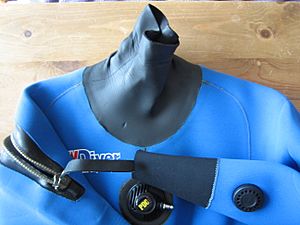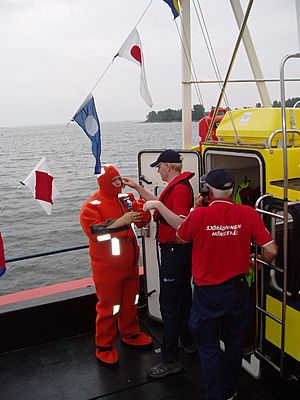Dry suit facts for kids
A dry suit is special clothing worn by divers when they swim in very cold water. Think of places like the Arctic Ocean or the Atlantic Ocean. A dry suit keeps a diver much warmer than a wetsuit does. While a wetsuit lets some water touch your body, a dry suit is completely sealed. This means no water gets inside the suit at all!
Contents
How Dry Suits Started
The first dry suits were designed in the 1930s by a company called Pirelli. Italian divers used these suits during World War II. These early suits were made from two pieces of thin, elastic rubber. Sometimes, they had a soft fabric lining, but not where the suit sealed at the neck, wrists, and waist. After the war, people who enjoyed diving for fun could buy these suits.
British divers in World War II used similar suits made by Siebe Gorman. Their suits changed a bit over the years, but they all had the same basic design.
In 1945, companies in California also started making rubber suits. The company B.F. Goodrich made the first special pressure-tight zipper in 1946. This new zipper was a big deal! It allowed divers to control how much air they put into or let out of their suit. This helped them control their buoyancy, which is how much they float or sink in the water.
Parts of a Dry Suit

Dry suits need a waterproof outer layer and special seals to keep water out. They usually also have valves to let air in and out.
The Outer Shell
The main part of a dry suit is its waterproof shell. This shell can be made from a thin "membrane" material, foamed neoprene, or a mix of both.
- Membrane Suits: These suits are made from thin materials that usually don't stretch. Because they don't stretch, they need to be a bit loose or "baggy" so you can move easily. To stay warm in a membrane suit, divers must wear a warm undersuit. You also have to be careful not to poke holes or tear this type of suit.
- Neoprene Suits: Neoprene is a type of synthetic rubber. When it's made, tiny air bubbles are trapped inside, making it warm and buoyant (it helps you float). Many wetsuits are also made from neoprene. Neoprene dry suits are often tighter and stretchier, which can make them harder to put on and take off. Even though they offer some warmth, divers usually wear warm undersuits in cold water with neoprene dry suits too.
- Hybrid Suits: Some dry suits combine the best parts of membrane and neoprene suits. They might have a membrane top attached to a neoprene bottom. This style is often used for water sports on the surface, especially in very cold water.
Seals
Seals at the neck and wrists are super important! They fit tightly against your skin to stop water from getting into the suit. While they are very good, a tiny bit of water might still get in sometimes. Seals are usually made from latex, rubber, or foam neoprene. You can also find them made from silicone rubber.
Waterproof Zippers
Modern dry suits have a special zipper that is completely waterproof. Often, this zipper goes across the back of the shoulders. Other common places for the zipper are diagonally across the front, straight down the middle of the back, or up one side of the front. Because these zippers are stiff, they can make it a bit tricky to get in and out of the suit. Before waterproof zippers, divers used a long rubber "tunnel" that they would fold and clamp shut after getting into the suit.
Who Uses Dry Suits?
For Fun and Sports
Boating and Water Sports
Dry suits are often worn for boating, especially sailing, and on personal watercraft during winter. These dry suits are not as tough as diving dry suits. They are made to protect boaters from splashes and from cold water if they accidentally fall overboard.
Dry suits are also used for windsurfing, kitesurfing, kayaking, water skiing, and other surface water sports. Membrane suits are popular in spring and autumn when the water is moderately cold. But for very cold water, people often prefer neoprene or hybrid dry suits.
Recreational Diving
People who dive for fun use dry suits when the water temperature is below 60 °F (15 °C) or when they plan to stay in the water for a long time. These suits come in both membrane and neoprene styles. Unlike surface dry suits, they have special valves to add and remove air, and they are usually tougher.
For Work and Safety
Working, Survival, and Rescue
People who work on commercial ships or fly in small planes over open water wear a type of dry suit called an immersion survival work suit. These suits usually have three parts:
- A warm undersuit that pulls sweat away from the skin.
- A dry suit made of a waterproof material that also lets moisture out.
- A strong outer layer to protect the dry suit and carry tools. This outer layer might even have a part that inflates to help the person float.
Large ships also carry dry suits just for emergencies. These suits are not worn all the time. They are usually one-piece suits that can be put on very quickly. They are often bright colors with reflective patches so people can be easily seen in the water.
Rescue workers also wear dry suits when they are helping people in cold water.
Commercial and Military Diving
Dry suits used for commercial (professional) and military diving are much heavier and tougher than those used for fun. This is because they are used in very harsh places. Divers might use them for underwater welding or diving in contaminated areas, like sewage pits or chemical tanks. These "hazmat suits" are often made of a fabric coated with vulcanized rubber. This material is easier to clean than others because it has a smooth surface. Boots, gloves, and a helmet are also part of the suit to keep the diver safe from contaminated water.
Cool Facts About Dry Suits
- A dry suit usually costs 4 to 5 times more than a wetsuit.
- Even though they cost more at first, dry suits can be cheaper over time because they are tougher and last longer than wetsuits.
- Dry suits also protect divers from too much sun.
- Neoprene suits fit more closely to the body. This means you need less air inside the suit, and it helps the diver move through the water more easily.
- Many dry suits have cool extras like pockets and padding built into them.
- It's important to wash a dry suit inside and out after every dive.
- Keeping the waterproof zippers waxed helps them last longer.
- Wrist and neck seals need to fit snugly to keep water out. But they shouldn't be too tight, or they could cause problems with breathing or blood flow.
Images for kids
-
Low pressure inflation hose with CEJN connector (right) used for some dry suits




























